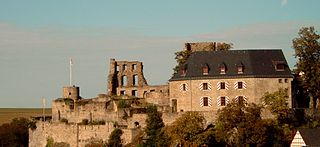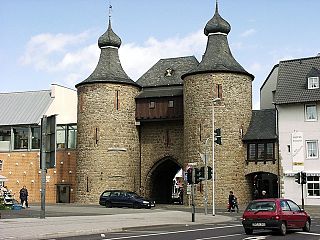
Idstein is a town of about 25,000 inhabitants in the Rheingau-Taunus-Kreis in the Regierungsbezirk of Darmstadt in Hesse, Germany. Because of its well preserved historical Altstadt it is part of the Deutsche Fachwerkstraße, connecting towns with fine fachwerk buildings and houses. In 2002, the town hosted the 42nd Hessentag state festival.

The inner bailey or inner ward of a castle is the strongly fortified enclosure at the heart of a medieval castle. It is protected by the outer ward and, sometimes also a Zwinger, moats, a curtain wall and other outworks. Depending on topography it may also be called an upper bailey or upper ward.

Weikersheim Palace is a palace in Weikersheim, Baden-Württemberg, Germany. It was a medieval seat and later a Renaissance residence of the princely House of Hohenlohe.

Mespelbrunn Castle is a late-medieval/early-Renaissance moated castle on the territory of the town of Mespelbrunn, between Frankfurt and Würzburg, built in a tributary valley of the Elsava valley, within the Spessart forest. It is a popular tourist attraction and has become a famous Spessart landmark.

Kastellaun Castle is a ruined medieval castle in Kastellaun in the Rhein-Hunsrück district in Rhineland-Palatinate, Germany.

Falkenstein Castle, also formerly called New Falkenstein Castle to distinguish it from Old Falkenstein Castle, is a German hill castle in the Harz Mittelgebirge, dating to the High Middle Ages. It is located in the town of Falkenstein between Aschersleben and Harzgerode.

Bergfried is a tall tower that is typically found in castles of the Middle Ages in German-speaking countries and in countries under German influence. Friar describes it as a "free-standing, fighting-tower". Its defensive function is to some extent similar to that of a keep in English or French castles. However, the characteristic difference between a bergfried and a keep is that a bergfried was typically not designed for permanent habitation.

The Wolfsburg is medieval lowland and water castle in North Germany that was first mentioned in the records in 1302, but has since been turned into a Renaissance schloss or palace. It is located in eastern Lower Saxony in the town of Wolfsburg named after it and in whose possession it has been since 1961. The Wolfsburg developed from a tower house on the River Aller into a water castle with the character of a fortification. In the 17th century it was turned into a representative, but nevertheless defensible palace that was the northernmost example of the Weser Renaissance style. Its founder and builder was the noble family of von Bartensleben. After their line died out in 1742 the Wolfsburg was inherited by the counts of Schulenburg.

"Zwinger" is a German word for outer ward or outer bailey. It represents an open kill zone area between two defensive walls that is used for defensive purposes. Zwingers were built in the post-classical and early modern periods to improve the defence of castles and town walls. The term is usually left untranslated, but is sometimes rendered as "outer courtyard", presumably referring to the subsequent role of a Zwinger as a castle's defences became redundant and it was converted into a palace or schloss; however, this belies its original purpose as a form of killing ground for the defence. The word is linked with zwingen, "to force", perhaps because the Zwinger forced an enemy to negotiate it before assaulting the main defensive line. Essenwein states that the "main purpose of this feature was so that the besieging force could not reach the actual castle wall very easily with battering rams or belfries, but had to stop at the lower, outer wall; also that two ranks of archers, behind and above one another, could fire upon the approaching enemy".

The ruins of Alt-Trauchburg Castle, also called the Alttrauchburg or Trauchburg, lie above the Weitnau hamlet of Kleinweiler in the county of Oberallgäu in Swabia. Large parts of the original stone walls of the high- to post-medieval castle remain. The ruins are some of the best preserved in the Allgäu region of Germany.

Grenzau Castle is a ruined spur castle at 250 m above sea level (NN) near Höhr-Grenzhausen in the county of Westerwaldkreis in the state of Rhineland-Palatinate. It is the only castle in Germany with a triangular bergfried.

The ruins of Sayn Castle, the 12th century family castle of the counts of Sayn and Sayn-Wittgenstein, are in Sayn, part of the borough of Bendorf on the Rhine, between Koblenz and Neuwied in the county of Mayen-Koblenz in the German state of Rhineland-Palatinate.

Greifenstein Castle lies in the eponymous village of Greifenstein in the county of Lahn-Dill-Kreis in Middle Hesse, Germany. It is a geo point in the national geopark of Westerwald-Lahn-Taunus.

Hohenfreyberg Castle, together with Eisenberg Castle directly opposite, forms a castle group in the southern Allgäu that is visible from a long way off. It is located about four kilometres north of Pfronten in the county of Ostallgäu. The late mediaeval hilltop castle was abandoned during the Thirty Years’ War and set on fire. From 1995 to 2006 the former aristocratic seat was comprehensively made safe and conserved as part of a closely observed "example of renovation".

Falkenstein Castle, also called New Falkenstein (Neu-Falkenstein), is a ruined hill castle at 450 m above sea level (NHN) in the eponymous climatic spa of Falkenstein, a quarter of Königstein im Taunus in the county of Hochtaunuskreis in the German state of Hesse.

A butter-churn tower is a two-part defensive tower in which the upper section has a smaller width than the lower section.

Witch tower or Witches' Tower is a common name or description in English and other European languages for a tower that was part of a medieval town wall or castle, often used as a prison or dungeon.

The ruins of Zavelstein Castle, a former hill castle, stand at 560 m above sea level (NN) on a hill spur above the Teinach valley on the southeastern edge of the municipality of Bad Teinach-Zavelstein in the county of Calw in the south German state of Baden-Württemberg.

Old Wolfstein Castle, is a ruined hillside castle on the eastern slopes of the Königsberg at the narrowest point in the Lauter valley near Wolfstein in the county of Kusel in the German state of Rhineland-Palatinate.

Pyrmont Castle stands west of Münstermaifeld near Roes and Pillig on a slate rock outcrop above a waterfall on the Elzbach in the southern Eifel mountains in Germany. It is in the municipality of Roes in the district of Cochem-Zell.























